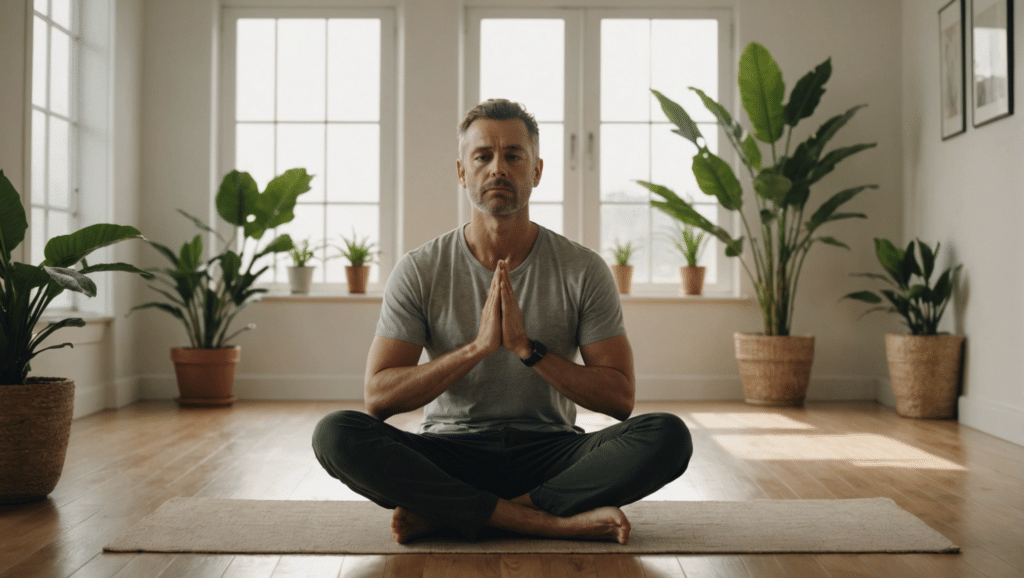Alternate nostril breathing is a simple yoga technique that helps calm the mind and reduce stress 1. People enjoy it for its clarity and peace.
How do you perform alternate nostril breathing?
Sit comfortably and close your right nostril with your thumb to perform alternate nostril breathing. Inhale slowly through the left nostril, close it with your finger, and exhale through the right nostril. Repeat the process by inhaling through the right and exhaling through the left.
This blog is part of a series on “breathing techniques.” The next blog is about pursed lip breathing.
Key Points About Alternate Nostril Breathing
- Technique Overview: Alternate closing of the left and right nostril to control breath flow.
- Health Benefits: Reduces stress, improves respiratory strength, and enhances mental clarity.
- Usage in Yoga: Often used to prepare the mind for meditation and improve focus.
- Instructional Tips: Begin with a comfortable seated position and focus on slow, steady breaths.
- Duration: Start with 5 minutes daily, gradually increasing as comfort with the practice grows.
- Risks: Best avoided during cold or nasal blockage; always practice gently to avoid discomfort.
- Integrating into Daily Routine: Effective before stressful activities or as part of a morning or evening ritual.
How to Practice Alternate Nostril Breathing
To start practicing alternate nostril breathing, find a comfortable seat. Place your left hand on your knee and lift your right hand to your nose. Use your right thumb to close your right nostril and inhale slowly through the left nostril. Hold your breath briefly, then use your ring finger to close the left nostril and exhale through the right nostril. This is one round of alternate nostril breathing.
Continue this pattern, always inhaling through the nostril you just exhaled from. Focus on keeping your breath slow and steady. This technique helps balance your nervous system and relax your mind. Practice for a few minutes each day to feel more centered and calm.
Benefits of Alternate Nostril Breathing
Alternate nostril breathing is more than just a breathing exercise; it’s a tool for better health. It can lower stress levels, improve respiratory strength, and increase mental clarity. By alternating breaths between nostrils, you balance your brain’s left and right hemispheres, promoting better emotional and physical health.
Regular practice can also enhance your focus and energy levels. It’s particularly effective before important meetings or as a way to decompress after a long day. It’s a staple in yoga practices, known for preparing the mind for meditation and deeper relaxation.
| Technique | Benefits | Optimal Duration |
|---|---|---|
| Alternate Nostril Breathing | Reduces stress, improves focus, balances brain hemispheres | 5-15 minutes daily |
| Nadi Shodhana | Calms mind, rejuvenates nervous system, sharpens focus | 10 minutes twice daily |
| 4-7-8 Breathing | Promotes sleep, reduces anxiety, controls cravings | 4 cycles before sleep or stressful events |
| Box Breathing | Increases concentration, regulates autonomic nervous system | 5 minutes per session, several times a day |
Breathing Exercises: Incorporating Nadi Shodhana
Nadi Shodhana, or alternate nostril breathing, is a yogic breath control practice. Start by sitting in a quiet place with a straight spine. Close your eyes and relax your body. Use your thumb and ring finger to control airflow through your nostrils with your right hand. Alternate the nostril through which you inhale and exhale, following a rhythmic pattern that soothes the mind and body.
This breathing technique calms your mind and rejuvenates your nervous system. It’s especially beneficial for those who lead hectic lives. Just a few rounds can help redirect your energy and sharpen your focus.

Optimal Duration: Minutes and Rounds of Breathing
How long should you practice alternate nostril breathing? Start with 5 minutes daily and gradually increase the duration as you get more comfortable with the practice. Aim for about 10-15 minutes for optimal benefits. It’s not just about duration but also the quality of each breath that counts.
Experiment with different speeds and lengths of breathing to find what works best for you. Whether it’s quick sessions before breakfast or a longer sequence at night, each session helps refine your breathing technique and enhances its benefits.
Managing Risks of Alternate Nostril Breathing
While alternate nostril breathing is safe for most, it’s important to practice it correctly to avoid any potential discomfort. If you have a cold or nasal blockage, waiting until you can breathe clearly through both nostrils might be best. Always ensure your breathing is gentle and not forced.
If you feel dizzy or uncomfortable, take a break and breathe normally. Consult a healthcare provider if you have concerns about how this practice might affect your health. Remember, like any exercise, proper technique and moderation are key to avoiding risks.
Personal Thoughts
In my struggle with chronic stress, I found alternate nostril breathing to be a helpful tool. It’s a simple, measurable way to regain calm and balance in tension.
This technique isn’t a cure-all, but practicing it regularly has been a stable addition to my routine, aiding significantly in managing daily stress.
Frequently Asked Questions
What are the health benefits of alternate nostril breathing?
Alternate nostril breathing helps reduce stress, enhances pulmonary function, and improves cardiovascular health. It balances the nervous system, supporting both relaxation and energy levels. Regular practice can enhance focus, mental clarity, and emotional stability, benefiting the mind and body.
How often should you practice alternate nostril breathing?
Practice alternate nostril breathing daily for at least 5 to 10 minutes for noticeable benefits. Gradually increase the duration as you become more comfortable with the technique. Consistent practice enhances its effects on reducing anxiety and increasing mental focus.
Can alternate nostril breathing improve sleep?
Practicing alternate nostril breathing can improve sleep quality by calming the mind and reducing stress. It helps regulate the body’s sleep-wake cycle by engaging the parasympathetic nervous system, which encourages relaxation and readiness for sleep. Performing the technique before bedtime can help ease the transition to sleep.
What is the significance of using the ring finger in this practice?
Using the ring finger to close one nostril in alternate nostril breathing is part of the traditional yogic practice known as Nadi Shodhana. This method is said to help balance the body’s energy channels. The ring finger, associated with earth elements, is believed to help stabilize and ground the body during the practice.




